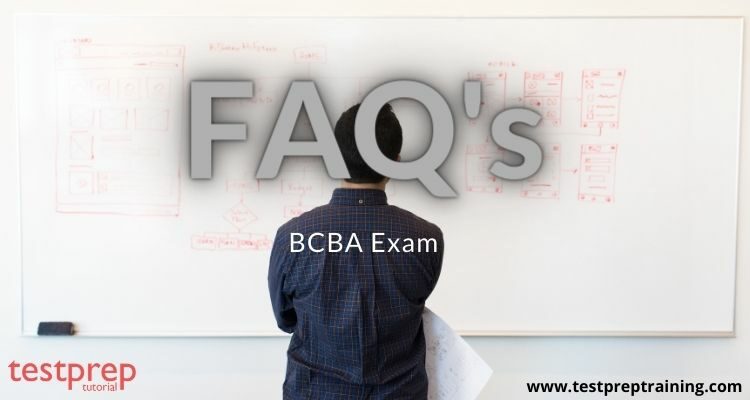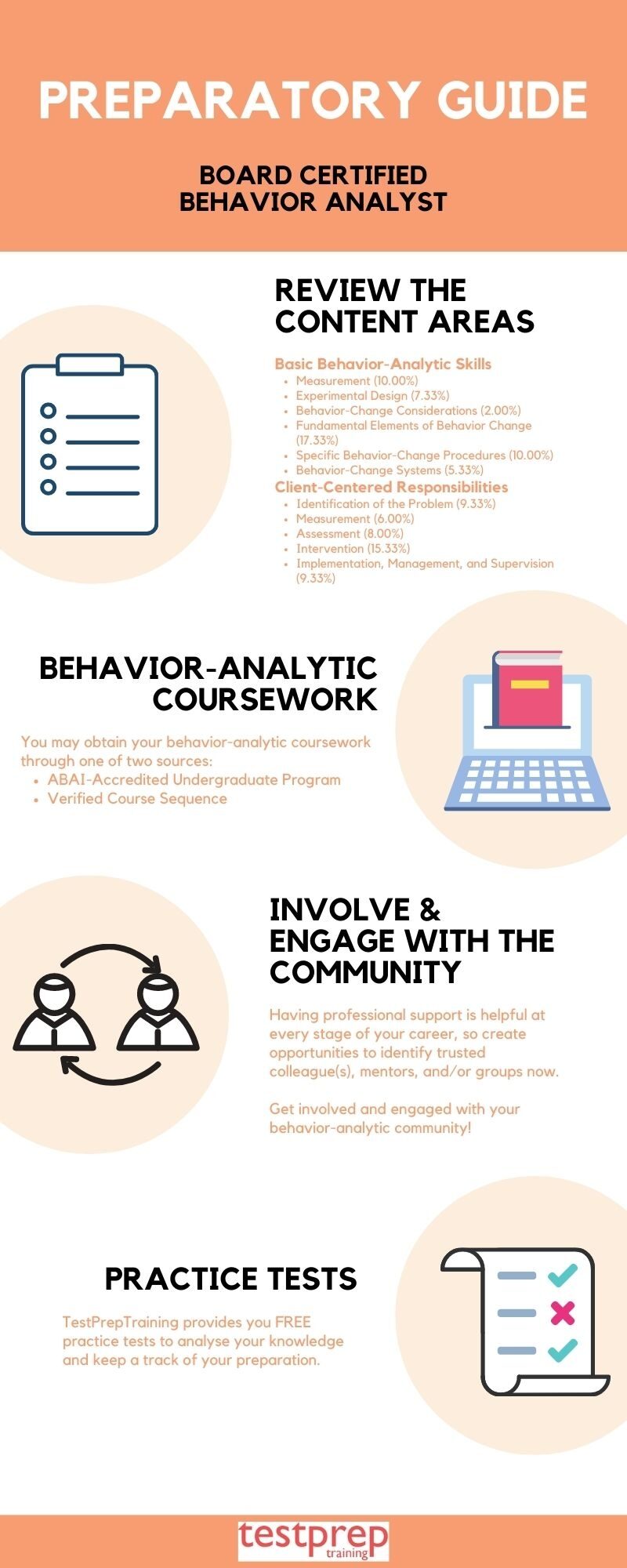Board Certified Behaviour Analyst (BCBA)

A graduate-level qualification in behaviour analysis is the Board Certified Behavior Analyst (BCBA). Independent practitioners who provide behavior-analytic services are BCBA-certified professionals. Board Certified Assistant Behavior Analysts (BCaBAs), Registered Behavior Technicians (RBTs), and other professions who provide behavior-analytic services may be supervised by BCBAs.
Certification Path

Exam Objectives
Firstly, Basic Behavior-Analytic Skills
- Measurement (10.00%)
- Experimental Design (7.33%)
- Behavior-Change Considerations (2.00%)
- Fundamental Elements of Behavior Change (17.33%)
- Specific Behavior-Change Procedures (10.00%)
- Behavior-Change Systems (5.33%)
Secondly, Client-Centered Responsibilities
- Identification of the Problem (9.33%)
- Measurement (6.00%)
- Assessment (8.00%)
- Intervention (15.33%)
- Implementation, Management, and Supervision (9.33%)
BCBA Exam Details
| Exam Name | Board Certified Behaviour Analyst |
| Exam Code | BCBA |
| Exam Partner | Pearson VUE |
| Exam Format | Multiple Choice Questions |
| Mode of Exam | Computer-based |
| Exam Duration | 4 hours |
| Total Number of Questions | 160 |
| Languages | English Spanish Chinese Simplified Chinese Traditional Hebrew Italian Polish Portuguese-Brazilian Korean Russian |
Fees Structure
| Certification Application | $245 |
| Examination Retake Application | $140 |
| Examination Appointment (paid to Pearson VUE) | $125 |
| Preliminary Coursework Evaluation | $100 |
| Preliminary Degree Evaluation | $100 |
Pre-requisites
The Board Certified Assistant Behavior Analyst (BCABA) Exam is a pre-requisite for BCBA. BCABA is a behavior analysis certification for undergraduates.
RBT certification was originally designed for settings in which a BCBA or BCaBA is already providing behavior analysis services. However, Professionals certified at the BCaBA level provide behavior-analytic services under the supervision of a Board Certified Behavior Analyst (BCBA).
Retake Policy
Following your initial examination approval, you have two years to repeat the exam for a total of eight tries. Within 48 hours of each failed examination attempt, an Examination Retake Application will be accessible online through your BACB account. Each time you repeat the test, you must pay a $140 retake application cost and a $125 examination appointment fee. Following your prior try, you will have to wait 30 days to repeat the exam.
Note: If you do not pass the examination after 8 attempts and you still have time in your 2-year authorization period, you will need to wait until your 2-year authorization period is over to reapply for BCBA certification.
Recertification Policy
As a BCBA, you are required to submit a recertification application (including payment) every two years. Recertification applications are available in your BACB account within 45 days of your recertification date & as soon as you have entered your required CEUs. You must complete your recertification application on or before your recertification date to avoid lapses in your certification and late fees
FAQ’s regarding Exam BCBA
To get any of your doubts regarding the exam sorted, visit: BCBA Exam – FAQ’s

Course Outline
Section 1: Basic Behavior-Analytic Skills
A. Measurement
A-01 Measure frequency (i.e., count).
A-02 Measure rate (i.e., count per unit time).
A-03 Measure duration.
A-04 Measure latency.
A-05 Measure interresponse time (IRT).
A-06 Measure percent of occurrence.
A-07 Measure trials to criterion.
A-08 Assess and interpret interobserver agreement.
A-09 Evaluate the accuracy and reliability of measurement procedures.
A-10 Design, plot, and interpret data using equal-interval graphs.
A-11 Design, plot, and interpret data using a cumulative record to display data.
A-12 Design and implement continuous measurement procedures (e.g., event recording).
A-13 Design and implement discontinuous measurement procedures (e.g., partial & whole interval, momentary time sampling).
A-14 Design and implement choice measures.
B. Experimental Design
B-01 Use the dimensions of applied behavior analysis (Baer, Wolf, & Risley, 1968) to evaluate whether interventions are behavior analytic in nature.
B-02 Review and interpret articles from the behavior-analytic literature.
B-03 Systematically arrange independent variables to demonstrate their effects on dependent variables.
B-04 Use withdrawal/reversal designs.
B-05 Use alternating treatments (i.e., multielement) designs.
B-06 Use changing criterion designs.
B-07 Use multiple baseline designs.
B-08 Use multiple probe designs.
B-09 Use combinations of design elements.
B-10 Conduct a component analysis to determine the effective components of an intervention package.
B-11 Conduct a parametric analysis to determine the effective values of an independent variable.
C. Behavior-Change Considerations
C-01 State and plan for the possible unwanted effects of reinforcement.
C-02 State and plan for the possible unwanted effects of punishment.
C-03 State and plan for the possible unwanted effects of extinction.
D. Fundamental Elements of Behavior Change
D-01 Use positive and negative reinforcement.
D-02 Use appropriate parameters and schedules of reinforcement.
D-03 Use prompts and prompt fading.
D-04 Use modeling and imitation training.
D-05 Use shaping.
D-06 Use chaining.
D-07 Conduct task analyses.
D-08 Use discrete-trial and free-operant arrangements.
D-09 Use the verbal operants as a basis for language assessment.
D-10 Use echoic training.
D-11 Use mand training.
D-12 Use tact training.
D-13 Use intraverbal training.
D-14 Use listener training.
D-15 Identify punishers.
D-16 Use positive and negative punishment.
D-17 Use appropriate parameters and schedules of punishment.
D-18 Use extinction.
D-19 Use combinations of reinforcement with punishment and extinction.
D-20 Use response-independent (time-based) schedules of reinforcement (i.e., noncontingent reinforcement).
D-21 Use differential reinforcement (e.g., DRO, DRA, DRI, DRL, DRH).
E. Specific Behavior-Change Procedures
E-01 Use interventions based on manipulation of antecedents, such as motivating operations and discriminative stimuli.
E-02 Use discrimination training procedures.
E-03 Use instructions and rules.
E-04 Use contingency contracting (i.e., behavioral contracts).
E-05 Use independent, interdependent, and dependent group contingencies.
E-06 Use stimulus equivalence procedures.
E-07 Plan for behavioral contrast effects.
E-08 Use the matching law and recognize factors influencing choice.
E-09 Arrange high-probability request sequences.
E-10 Use the Premack principle.
E-11 Use pairing procedures to establish new conditioned reinforcers and punishers.
E-12 Use errorless learning procedures.
E-13 Use matching-to-sample procedures.
F. Behavior-Change Systems
F-01 Use self-management strategies.
F-02 Use token economies and other conditioned reinforcement systems.
F-03 Use Direct Instruction.
F-04 Use precision teaching.
F-05 Use personalized systems of instruction (PSI).
F-06 Use incidental teaching.
F-07 Use functional communication training.
F-08 Use augmentative communication systems.
Section 2: Client-centered Responsibilities
G. Identification of the Problem
G-01 Review records and available data at the outset of the case.
G-02 Consider biological/medical variables that may be affecting the client.
G-03 Conduct a preliminary assessment of the client in order to identify the referral problem.
G-04 Explain behavioral concepts using nontechnical language.
G-05 Describe and explain behavior, including private events, in behavior-analytic (nonmentalistic) terms.
G-06 Provide behavior-analytic services in collaboration with others who support and/or provide services to one’s clients.
G-07 Practice within one’s limits of professional competence in applied behavior analysis, and obtain consultation, supervision, and training, or make referrals as necessary.
G-08 Identify and make environmental changes that reduce the need for behavior analysis services.
H. Measurement
H-01 Select a measurement system to obtain representative data given the dimensions of the behavior and the logistics of observing and recording.
H-02 Select a schedule of observation and recording periods.
H-03 Select a data display that effectively communicates relevant quantitative relations.
H-04 Evaluate changes in level, trend, and variability.
H-05 Evaluate temporal relations between observed variables (within & between sessions, time series).
I. Assessment
I-01 Define behavior in observable and measurable terms.
I-02 Define environmental variables in observable and measurable terms.
I-03 Design and implement individualized behavioral assessment procedures.
I-04 Design and implement the full range of functional assessment procedures.
I-05 Organize, analyze, and interpret observed data.
I-06 Make recommendations regarding behaviors that must be established, maintained, increased, or decreased.
I-07 Design and conduct preference assessments to identify putative reinforcers.
J. Intervention
J-01 State intervention goals in observable and measurable terms.
J-02 Identify potential interventions based on assessment results and the best available scientific evidence.
J-03 Select intervention strategies based on task analysis.
J-04 Select intervention strategies based on client preferences.
J-05 Select intervention strategies based on the client’s current repertoires.
J-06 Select intervention strategies based on supporting environments.
J-07 Select intervention strategies based on environmental and resource constraints.
J-08 Select intervention strategies based on the social validity of the intervention.
J-09 Identify and address practical and ethical considerations when using experimental designs to demonstrate treatment effectiveness.
J-10 When a behavior is to be decreased, select an acceptable alternative behavior to be established or increased.
J-11 Program for stimulus and response generalization.
J-12 Program for maintenance.
J-13 Select behavioral cusps as goals for intervention when appropriate.
J-14 Arrange instructional procedures to promote generative learning (i.e., derived relations).
J-15 Base decision-making on data displayed in various formats.
K. Implementation, Management, and Supervision
K-01 Provide for ongoing documentation of behavioral services.
K-02 Identify the contingencies governing the behavior of those responsible for carrying out
behavior-change procedures and design interventions accordingly.
K-03 Design and use competency-based training for persons who are responsible for carrying out behavioral assessment and behavior-change procedures.
K-04 Design and use effective performance monitoring and reinforcement systems.
K-05 Design and use systems for monitoring procedural integrity.
K-06 Provide supervision for behavior-change agents.
K-07 Evaluate the effectiveness of the behavioral program.
K-08 Establish support for behavior-analytic services from direct and indirect consumers.
K-09 Secure the support of others to maintain the client’s behavioral repertoires in their
natural environments.
K-10 Arrange for the orderly termination of services when they are no longer required.
Section 3: Foundational Knowledge
Explain and Behave in Accordance with the Philosophical Assumptions of Behavior Analysis
FK-01 Lawfulness of behavior
FK-02 Selectionism (phylogenic, ontogenic, cultural)
FK-03 Determinism
FK-04 Empiricism
FK-05 Parsimony
FK-06 Pragmatism
FK-07 Environmental (as opposed to mentalistic) explanations of behavior
FK-08 Distinguish between radical and methodological behaviorism.
FK-09 Distinguish between the conceptual analysis of behavior, experimental analysis of behavior, applied behavior analysis, and behavioral service delivery.
Define and Provide Examples of:
FK-10 behavior, response, response class
FK-11 environment, stimulus, stimulus class
FK-12 stimulus equivalence
FK-13 reflexive relations (US-UR)
FK-14 respondent conditioning (CS-CR)
FK-15 operant conditioning
FK-16 respondent-operant interactions
FK-17 unconditioned reinforcement
FK-18 conditioned reinforcement
FK-19 unconditioned punishment
FK-20 conditioned punishment
FK-21 schedules of reinforcement and punishment
FK-22 extinction
FK-23 automatic reinforcement and punishment
FK-24 stimulus control
FK-25 multiple functions of a single stimulus
FK-26 unconditioned motivating operations
FK-27 conditioned motivating operations
FK-28 transitive, reflexive, surrogate motivating operations
FK-29 distinguishing between the discriminative stimulus and the motivating operation
FK-30 distinguishing between motivating operation and reinforcement effects
FK-31 behavioral contingencies
FK-32 contiguity
FK-33 functional relations
FK-34 conditional discriminations
FK-35 stimulus discrimination
FK-36 response generalization
FK-37 stimulus generalization
FK-38 behavioral contrast
FK-39 behavioral momentum
FK-40 matching law
FK-41 contingency-shaped behavior
FK-42 rule-governed behavior
Distinguish between the Verbal Operants
FK-43 Echoics
FK-44 Mands
FK-45 Tacts
FK-46 Intraverbals
Measurement Concepts
FK-47 Identify the measurable dimensions of behavior (e.g., rate, duration, latency, interresponse time).
FK-48 State the advantages and disadvantages of using continuous measurement procedures and discontinuous measurement procedures (e.g., partial- and whole-interval recording, momentary time sampling).
Preparatory Guide: BCBA Exam

Review the content areas
Content on the BCBA Task List (4th ed.) serves as the basis of the examination. Although the BACB cannot endorse specific study guides or other preparation materials, we do recommend that candidates review the task list, materials from their training, and the Professional and Ethical Compliance Code for Behavior Analysts and study the content areas.
Behavior-analytic Coursework
You may obtain your behavior-analytic coursework through one of two sources:
• ABAI-Accredited Graduate Program: Behavior-analytic graduate programs that have been accredited by ABAI have met ABAI’s accreditation standards, which include standards for the curriculum, faculty, and resources, among other areas. Accredited programs may be found on ABAI’s Accredited Programs web page.
• Verified Course Sequence: The other option for completing behavior-analytic coursework is through a Verified Course Sequence. A Verified Course Sequence is a set of courses that have been verified by ABAI as having met the BACB’s behavior-analytic coursework requirements.
Involve & Engage with the Community
Get involved and engaged with your behavior-analytic community! This might include joining or volunteering with your local, regional, or national professional associations and groups focused in your area(s) of interest. Also, you will likely learn a lot and have an opportunity to contribute to behavior analysis and its consumers.
Therefore having professional support is helpful at every stage of your career, so create opportunities to identify trusted colleague(s), mentors, and/or groups now.
Practice Tests
Practice tests are built to keep up with the progress of the preparation. Further, not only that but also to make students familiar with the exam in real time environment. Preparing along with giving practice tests is a really important step towards your journey to clear the exam. Also, attempting practice questions build your confidence and helps you perform better.
TestPrepTraining provides you FREE practice tests to analyse your knowledge and keep a track of your preparation.

